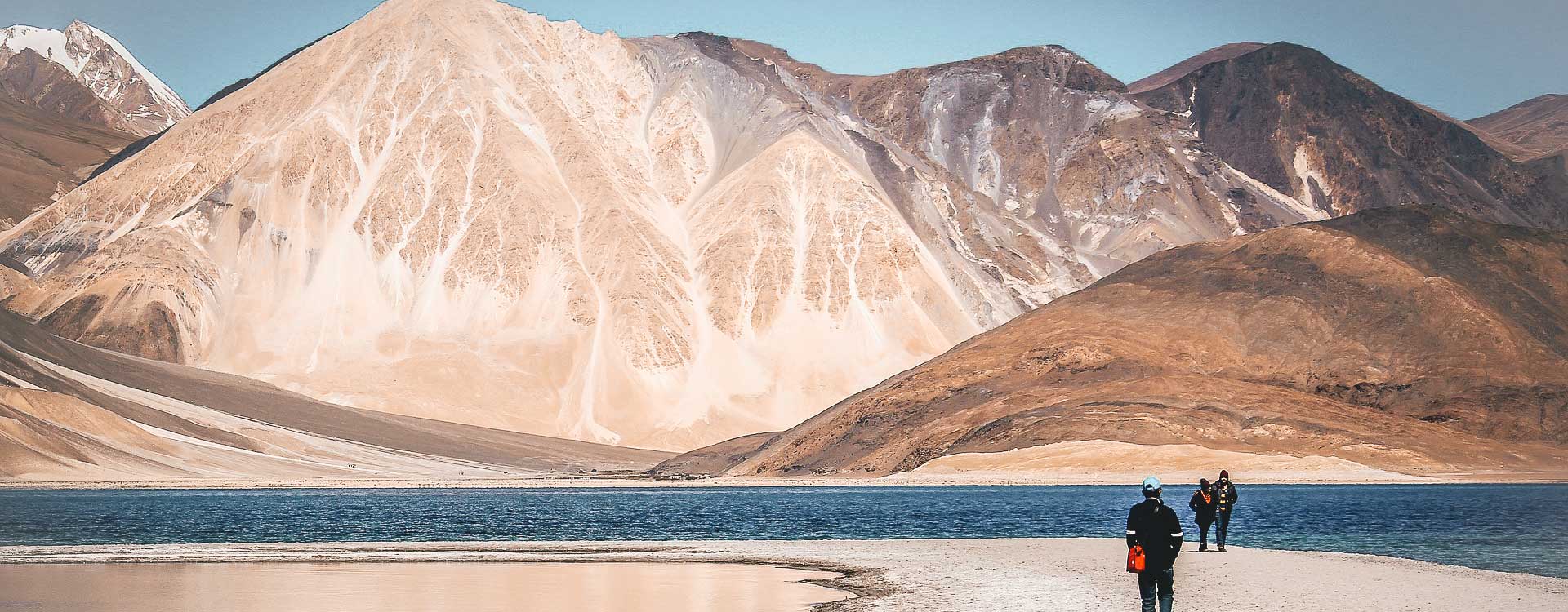Ladakh, a word which means "land of high passes", is a region in the Northern India sandwiched between the Karakoram mountain range to the north and the Himalayas to the south and is situated at the height of 11,400 ft.
The Indian portion of Ladakh is composed of the Leh and Kargil districts.
History of Ladakh
About Ladakh history, the earliest inhabitants of Ladakh were the Khampa nomads, who domesticated yaks. The first settlement along the Indus River was established by Mons from the region of Kullu and another tribe called the Brokpas, toward the west of Ladakh, originating from Giglit. Gya became the first seat of government of a Mon ruler who was known by the name of Gyapacho. Around 10th century AD in ladakh history, nomads from Khotan launched a series of bloody invasions in Ladakh. Gyapacho succeeded in repelling the attack of the Khotan nomads with the help of Skilde Nimagon, the decendant Kin Tibet. Gyapocho ceded to him the uninhabited Shey and Thiksey village in return of his help. Nimagon became the first king of Ladakh in ladakh history and chose Shey as the headquarter, and built a fort at Shey. Later he became the king of entire Ladakh region. Skilde Namagon ruled from 975 to 1000 AD. Between 1000 and 1500 AD Ladakh was ruled by succession of kings, who were great patrons of art and architecture. They were responsible for building palaces and promoting religious activities amongst other things.
By the beginning of the 19th century in Ladakh history, the Mughal empire had misshapen, and Sikh rule had been established in Punjab and Kashmir. However the Dogra region of Jammu remained under its Rajput rulers, the greatest of whom was Maharaja Gulab Singh whose General Zorawar Singh entered Ladakh in 1834. King Tshespal Namgyal was deposed and exiled to Stok. Ladakh came under Dogra rule and was integrated into the state of Jammu and Kashmir in 1846. It still upheld substantial independence and connections with Tibet. Throughout the Sino-Sikh war from 1841 to 1842 in history of Ladakh, the Qing Empire attacked on Ladakh and the Sino-Tibetan army was crushed.The Dogras led by Zorawar Singh invaded Ladakh in 1834. King Dorjay Namgyal of Ladakh managed to hold the Dogra army at Mulbek for a few months. Eventually, they had to surrender. Ladakh was placed under the control of Gulab Singh and his Governer. This followed a constant strife by the Ladakhis to regain their freedom in Ladakh history. This bloody period ended with the advent of the British as the paramount power in North India. Ladakh was incorporated in the newly created state of Jammu and Kashmir.
Best Time to Visit in Ladakh
Ladakh in Jammu and Kashmir is one of the most cherished dreams for many. Enjoy the sights of the vast and desolate expanse of hills and valleys. This along with the thrilling experience of enduring the harsh climate is one of its kind adventures. While some people suggest summers to be the best time to visit the place as the weather is most exciting and amiable. The snow has melted and there is a buzz of activity with the colorful and vibrant Hemis Festival taking place.On the other hand, according to some, winters have their own charm when only a handful of travelers visit the place. The site is all covered with snow and the views are most breathtaking. This is also the time when one of the most adventurous treks of the world, the Chadar-Trek starts. Adventure lovers find it bliss to walk over the majestic and frozen Zanskar River. But nevertheless, each time of the year has its own allure and deciding the best time to visit the place often becomes confusing.If this seems to be the case with you then the information below will help you a lot.
How to Reach Ladakh
Ladakh is called the adventure capital of the country for a genuine reason. The geographical location of the place makes it an ultimate destination for anyone looking for an adrenaline filled vacation. Ladakh is one of the very few destinations in the world where the entertainment starts the moment you begin your travel towards it. Thanks to the scenic routes, the travel to Ladakh is as exciting as your vacation. The land is bestowed with mountains, valleys, snows, cold desert, frozen lakes, trekking routes, rivers, mountain passes and so on.
By Air
The easiest way to travel to Ladakh is by air. The nearest airport is Kushok Bakula Rimpochee Airport located in Leh. This airport is connected with many international airports in India like Delhi. It also receives flights from Srinagar, Jammu, Chandigarh and other common destinations in India. The airport is a military terminal and thus, the security is a bit strangling. It is important to have all your documents ready when you enter Ladakh via the airport. It is better to have a hard copy of your e-ticket.
By Bus
There are government and private buses from Srinagar and Manali. If you are choosing Srinagar, you will pass through Zoji La Pass to reach Ladakh and you will scale Rohtang Pass to reach Ladakh from Manali.The Srinagar path is open from June to October for bus entries. The Manali route is open for bus routes from June to September. If you were planning to hire bus from New Delhi, it would take minimum 4 days to reach Ladakh
By Train
The nearest railway station to Ladakh is in Tawi, which is 700 km away from Ladakh. This railway station receives trains from many important destinations like Kolkata, Mumbai, Delhi and others. From the station, you can find cabs to reach Ladakh. You can also pre-book cabs. It would take two days to reach Ladakh and the trip will cost INR 10,000. Other nearest railway stations are in Chandigarh and Pathankot. It would take at least three days to reach from the railway station to Ladakh. This is the most inconvenient method to reach Ladakh.
By Bike
The place has the world’s top three highest mountain passes that can be scaled on a vehicle. Biking along the mountain passes and stopping for a steaming cup of tea is the iconic activity of this place. If you are planning to travel to Leh via bike, you can choose one of two routes.
Shopping in Ladakh
It is hard to visit a place and also come back empty-handed to your folks waiting with wagging tongues for your exploits. You never ever disappoint them – that’s rule number one to living a lengthy life. What’s harder still is to rip your eyes and heart off the excellent surface and also people, the spiritual, happy culture, vibes of freedom as well as the preference of bliss that exist on a platter in Leh Ladakh, without as much as bringing home souvenirs and memorabilia that will assist you down the path of retrospection.
Best Things To Do in Ladakh
The best thing Ladakh ever-changing colours of Pangong lake set against the intense blue sky make it one of the most spectacular sites in Ladakh. Pangong Tso is a glacial lake approximately 150 kilometres long, spreading out over India and China. Only 5 hours of driving distance from Leh, this lake is cannot be missed when you are Ladakh. Nestled amidst the mountains at a height of 4350 metres though it is, Pangong Tso maintains a liquid state year-round owing to its saline content. The beauty of this lake against the backdrop of the majestic mountains is one of the most powerful sights in the world as well as the most peace-giving. Pangong Tso brings the depth of nature’s creativity to light in full force and makes you want to bow in reverence before it. You can also indulge yourself in camping around Pangong Lake which will give you some spectacular views of the lake. This is one place you absolutely must visit when in Ladakh.






